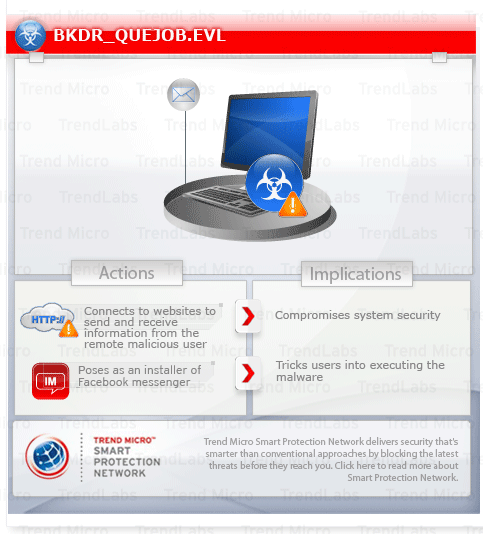BKDR_QUEJOB.EVL
Windows 2000, Windows XP, Windows Server 2003


Threat Type: Backdoor
Destructiveness: No
Encrypted: No
In the wild: Yes
OVERVIEW
This backdoor is noteworthy as it poses as an installer of Facebook messenger.
To get a one-glance comprehensive view of the behavior of this Backdoor, refer to the Threat Diagram shown below.

This backdoor arrives as an attachment to email messages spammed by other malware/grayware or malicious users.
TECHNICAL DETAILS
TCP port 1098 (RMI Activation)
45,568 bytes
EXE
Yes
15 Apr 2011
Arrival Details
This backdoor arrives as an attachment to email messages spammed by other malware/grayware or malicious users.
Installation
This backdoor drops the following non-malicious file:
- %Application Data%\common.data
(Note: %Application Data% is the current user's Application Data folder, which is usually C:\Windows\Profiles\{user name}\Application Data on Windows 98 and ME, C:\WINNT\Profiles\{user name}\Application Data on Windows NT, and C:\Documents and Settings\{user name}\Local Settings\Application Data on Windows 2000, XP, and Server 2003.)
Autostart Technique
This backdoor adds the following registry entries to enable its automatic execution at every system startup:
HKEY_LOCAL_MACHINE\SOFTWARE\Microsoft\
Windows\CurrentVersion\Run
AutoStart = "{malware path and file name}.exe"
NOTES:
Backdoor Routine
This backdoor opens the following port(s) where it listens for remote commands:
- TCP Port 1098
It executes the following commands from a remote malicious user:
- Update itself
- Download and execute files
- Start a process
It connects to the following URL(s) to send and receive commands from a remote malicious user:
- {BLOCKED}.{BLOCKED}.216.50
Other Details
This backdoor queries if antivirus products are installed on the infected system. The result is then sent to the following SMTP server via email:
- smtp.{BLOCKED}il.ru
It also checks the OS version used by the infected system. It then sends the gathered information to the remote server.
This backdoor poses as an installer of Facebook messenger.
SOLUTION
8.900
7.982.05
18 Apr 2011
7.983.00
18 Apr 2011
Step 1
For Windows XP and Windows Server 2003 users, before doing any scans, please make sure you disable System Restore to allow full scanning of your computer.
Step 2
Terminate a process file/s detected as BKDR_QUEJOB.EVL
*Note: If the detected file/s is/are not displayed in theWindows Task Manager, continue doing the next steps.
Step 3
Delete this registry value
Important: Editing the Windows Registry incorrectly can lead to irreversible system malfunction. Please do this step only if you know how or you can ask assistance from your system administrator. Else, check this Microsoft article first before modifying your computer's registry.
- In HKEY_LOCAL_MACHINE\SOFTWARE\Microsoft\Windows\CurrentVersion\Run
- AutoStart = "{malware path and file name}.exe"
Step 4
Search and delete this file
- %Application Data%\common.data
Step 5
Scan your computer with your Trend Micro product to delete files detected as BKDR_QUEJOB.EVL. If the detected files have already been cleaned, deleted, or quarantined by your Trend Micro product, no further step is required. You may opt to simply delete the quarantined files. Please check this Knowledge Base page for more information.
Did this description help? Tell us how we did.

